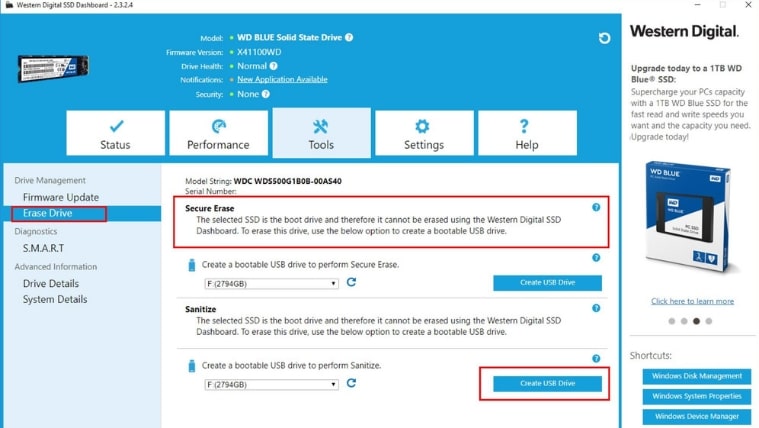

- #ATA SECURE ERASE WINDOWS 10 INSTALL#
- #ATA SECURE ERASE WINDOWS 10 CODE#
- #ATA SECURE ERASE WINDOWS 10 WINDOWS 8#
If all this seems like too much, there's another alternative - use whole-drive disk encryption before you copy any data to the SSD. If you are concerned that a hacker might get this image, print a few copies and store them in a secure location (like a file cabinet) and then erase the image file.
#ATA SECURE ERASE WINDOWS 10 INSTALL#
I suppose the important lesson here is that when you install a new SSD into a computer, photograph the cover to make a record of the PSID number. Unfortunately, if your label is removed or damaged, you may not be able to read it and there is usually no other way to get this number. Fortunately, most SSDs print the PSID on the drive's label.
#ATA SECURE ERASE WINDOWS 10 CODE#
Unfortunately, in order for this to work, you need the drive's PSID code - this is a secure ID designed to prevent malware from bypassing security features. You can use this utility to reset the SSD's firmware, which will re-enable the secure erase command. To get around this problem, you need to get a copy of the SSD manufacturer's drive utility. Why they do this may be an interesting topic for discussion, but doesn't really matter if you've got a retired drive that you want to erase.


#ATA SECURE ERASE WINDOWS 10 WINDOWS 8#
It would appear that the act of installing Windows 8 or 10 on an SSD involves writing some data to the drive that disables the secure erase command. When supported on an SSD, it performs a flash-level erase on every single block, ensuring that no data will be available to recover.Īnd now, with this background material in mind, the linked MacInTouch posting now make sense. The ATA specification (at the heart of all ATA and SATA devices) includes a command for explicitly and securely erasing a device. Which is where the ATA secure erase command comes into play. But both options are possible for someone willing to pay a data recovery company or some other similarly capable forensics lab. Mind you, this "garbage" data is not accessible using any software-accessible interface (SATA, SCSI, USB, etc.) The only way to read garbage data is to install special firmware into the SSD controller or to physically remove the chips. That time might be quickly, or it might not be for days or even months, depending on the SSD controller's algorithm and the drive's usage pattern. Writing zeros to a logical block of data does not necessarily overwrite the flash memory containing the old data - it is more likely that the flash memory will be marked as "garbage" for collection (which will truly erase it) at some non-deterministic time in the future. Tehnologies like wear leveling, garbage collection and TRIM make it difficult or impossible to know if data has truly been erased.

With an SSD, however, erasure by overwriting new data is not effective. They take a long time, but are generally considered secure enough for all but the most sensitive data (which should only be "erased" via physical destruction of the drive.) If you're paranoid about leaving magnetic after-images, there are various algorithms for writing various patterns designed to obscure any magnetic residue of old files. With a hard drive, you can use all kinds of standard disk-erase utilities to write zeros to every block. For those who aren't seriously into computer technology, there are technological issues with erasing an SSD.


 0 kommentar(er)
0 kommentar(er)
